Why you should choose to play flugelhorn
The flugelhorn is highly similar to the trumpet, which makes it easy for experienced trumpeters to jump from one to the other and back. But the flugelhorn offers a deeper and darker tone that is widely beloved by jazz and brass band musicians. In addition, flugelhorns are often smoother to play than trumpets, making them fun and exciting for musicians who have some experience with the trumpet.
For professional musicians, learning to play the flugelhorn can have monetary benefits. The flugelhorn isn’t an extremely common instrument, which makes flugelhorn players all the more valuable within existing bands and for gigs.
Give it to the sound – music for a flugelhorn
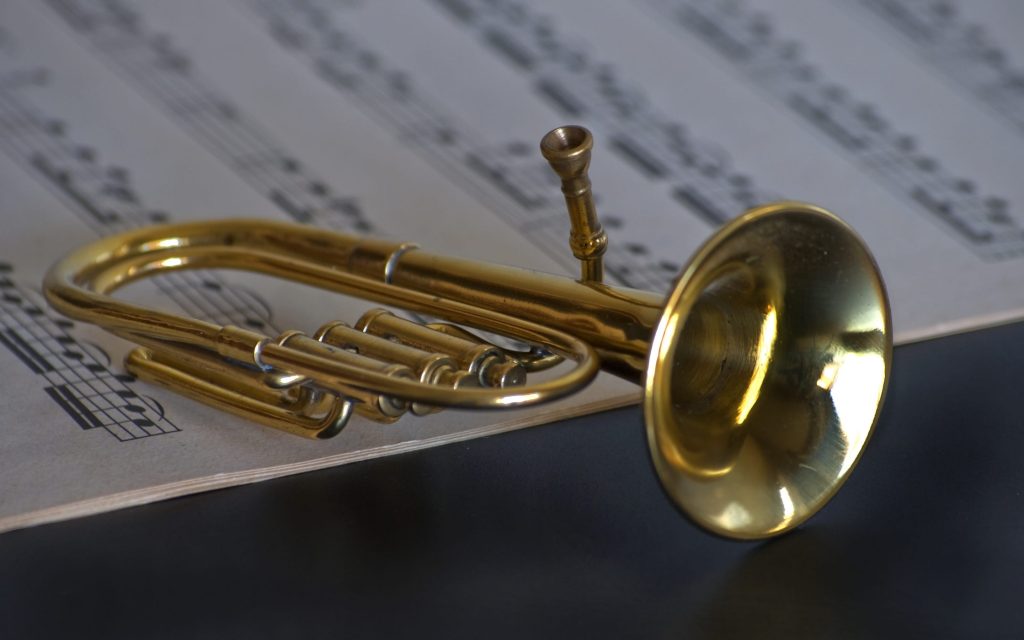 The dark, yet smooth tone of flugelhorns makes it a favorable addition to a wide variety of music styles. This instrument is most commonly used with brass and jazz bands, and it can often be included in concert bands as well. Although orchestras don’t always have flugelhorns, there are many pieces that do call for a flugelhorn accompaniment. While most flugelhorn musicians focus on improving their skills in one of these four types of music, there are no rules against playing multiple different types of styles with your flugelhorn.
The dark, yet smooth tone of flugelhorns makes it a favorable addition to a wide variety of music styles. This instrument is most commonly used with brass and jazz bands, and it can often be included in concert bands as well. Although orchestras don’t always have flugelhorns, there are many pieces that do call for a flugelhorn accompaniment. While most flugelhorn musicians focus on improving their skills in one of these four types of music, there are no rules against playing multiple different types of styles with your flugelhorn.
Price tag
Flugelhorns are not the most expensive instrument, but like any musical instrument they can get pricey as the quality of the brass and design goes up. Budget flugelhorns, like the Levante or Hawk horns, can be had for under $600. On the other hand, professional flugelhorns like the Yamaha model can cost nearly $2,000.
Features to consider while buying the best flugelhorn
When it comes to finding the right flugelhorn for you, there are a number of important features of these horns to consider. Here, we’ll take a look at the most essential features and explain how they can impact the sound and playability of your flugelhorn.
Your skills
Your skill level will be an important component to think about when choosing a flugelhorn. Beginner flugelhorns, like the RS Berkeley horn, are designed to be easier for beginners to move air through and are more forgiving when it comes to making quality sound. Professional horns like the Yamaha, on the other hand, can give you more control over the instrument’s sound and key movements but may be discouraging for musicians who are new to the flugelhorn.
Valves
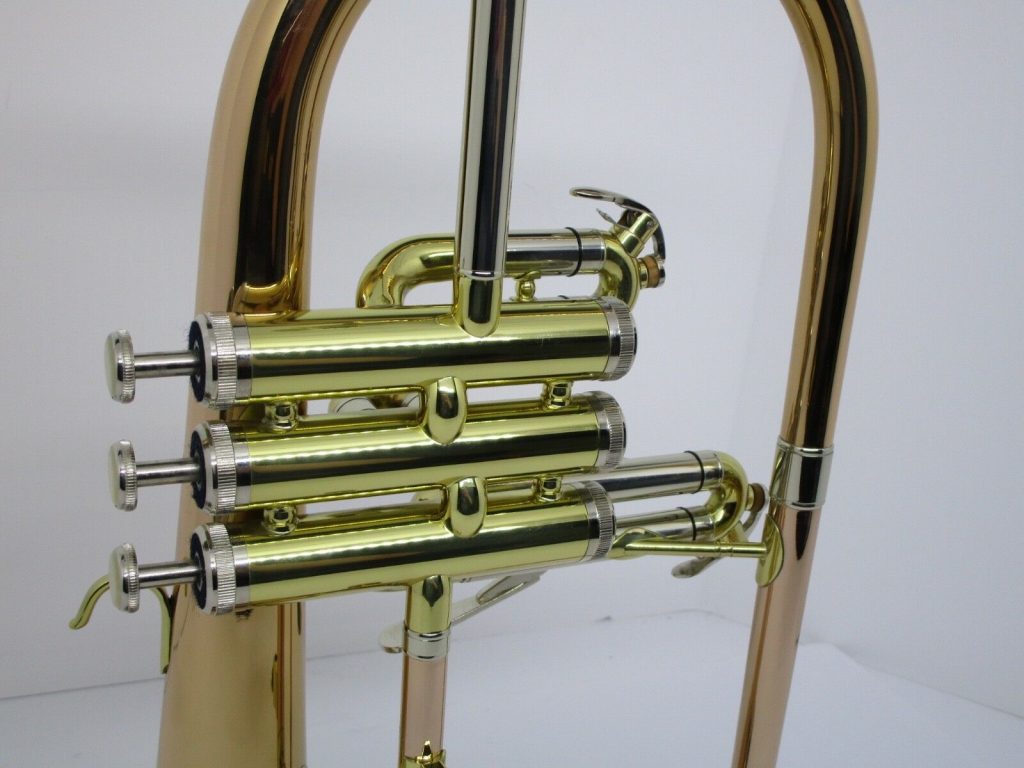 The vast majority of flugelhorns, including all of the instruments we reviewed, use a three-valve configuration. These flugelhorns include a slide trigger that allows you to extend the range of the instrument with deeper notes.
The vast majority of flugelhorns, including all of the instruments we reviewed, use a three-valve configuration. These flugelhorns include a slide trigger that allows you to extend the range of the instrument with deeper notes.
However, there are some flugelhorns that add the deeper range with a fourth valve. While some musicians may prefer this extra valve, it can add extra weight to the instrument that can become cumbersome when playing at longer gigs.
Material and finish
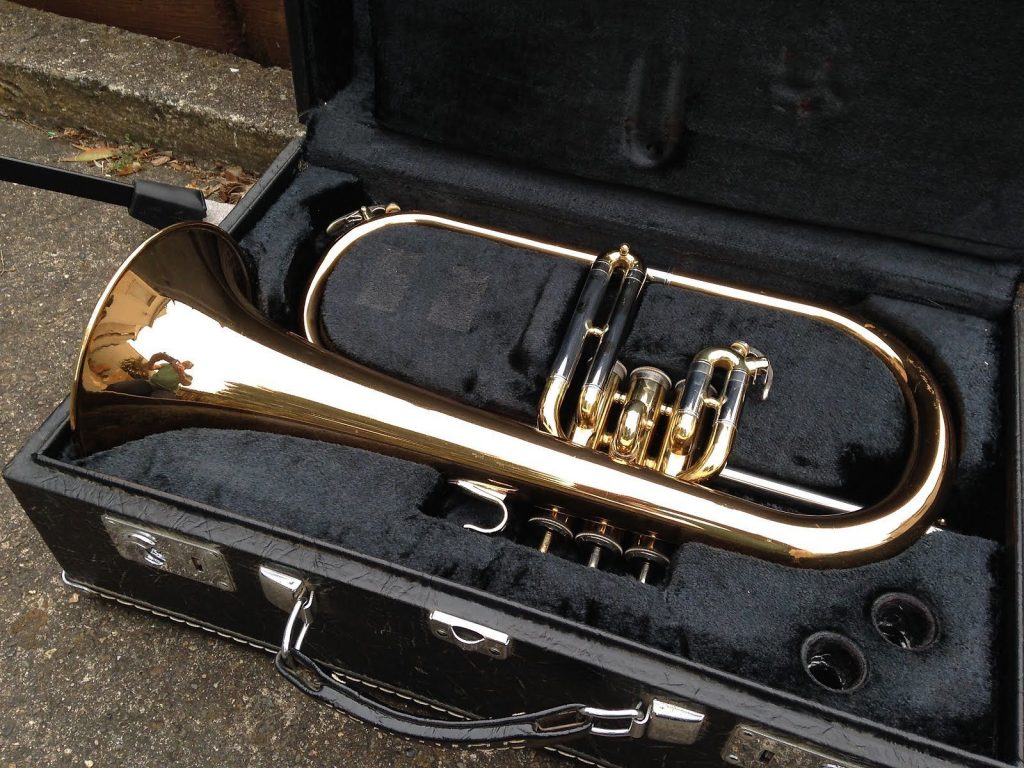 The finish of your flugelhorn’s brass is more than just aesthetic – the finish can also affect sound quality. Silver brass typically produces a brighter sound, closer to the sound of a trumpet, while a yellow or gold brass finish produces the darker sound that flugelhorns are known for. As a result, most flugelhorns opt for a gold brass finish.
The finish of your flugelhorn’s brass is more than just aesthetic – the finish can also affect sound quality. Silver brass typically produces a brighter sound, closer to the sound of a trumpet, while a yellow or gold brass finish produces the darker sound that flugelhorns are known for. As a result, most flugelhorns opt for a gold brass finish.
Tone
The sound of a flugelhorn is unique among brass instruments and is often described as deep, dark, and resonant. When choosing a flugelhorn, it’s important not to select an instrument that sounds like a trumpet – you want a flugelhorn that has the distinctive tone that this instrument is know for. Note that because of the flugelhorn’s propensity for deeper, darker tones, it can be difficult to control notes made in the highest register of the instrument.
Size and weight
While flugelhorns do not vary much in size or weight, the small variation can have a big difference on your playing style. A lighter flugelhorn, like the Levante or Bach instruments, can be easier to hold for longer periods if you frequently play extended gigs. At the same time, the smaller box of these flugelhorns further distinguishes their sound from that of trumpets.
That said, there is nothing wrong with larger or heavier flugelhorns. It is important to make sure the flugelhorn feels balanced in your hand and matches your playing style.
Bore size
Compared to trumpets, the bore sizes of flugelhorns can vary widely – which means that similar-looking flugelhorns can produce very different types of sound. Large-bore flugelhorns, like the Hawk horn, play more like a trumpet and can be ideal for beginners since they make it easier to move air through the horn. Flugelhorns with larger bores are also capable of producing more volume, although this is not a concern for most players.
The remainder of the flugelhorns we reviewed are medium-bore flugelhorns, since small-bore flugelhorns have bores on the order of 0.415 inches. The smaller the bore of the flugelhorn, the more distinctive the sound. But at the same time, musicians are likely to face more air resistance when playing with a smaller bore, which can be difficult for beginner and intermediate players alike.
Mouthpiece
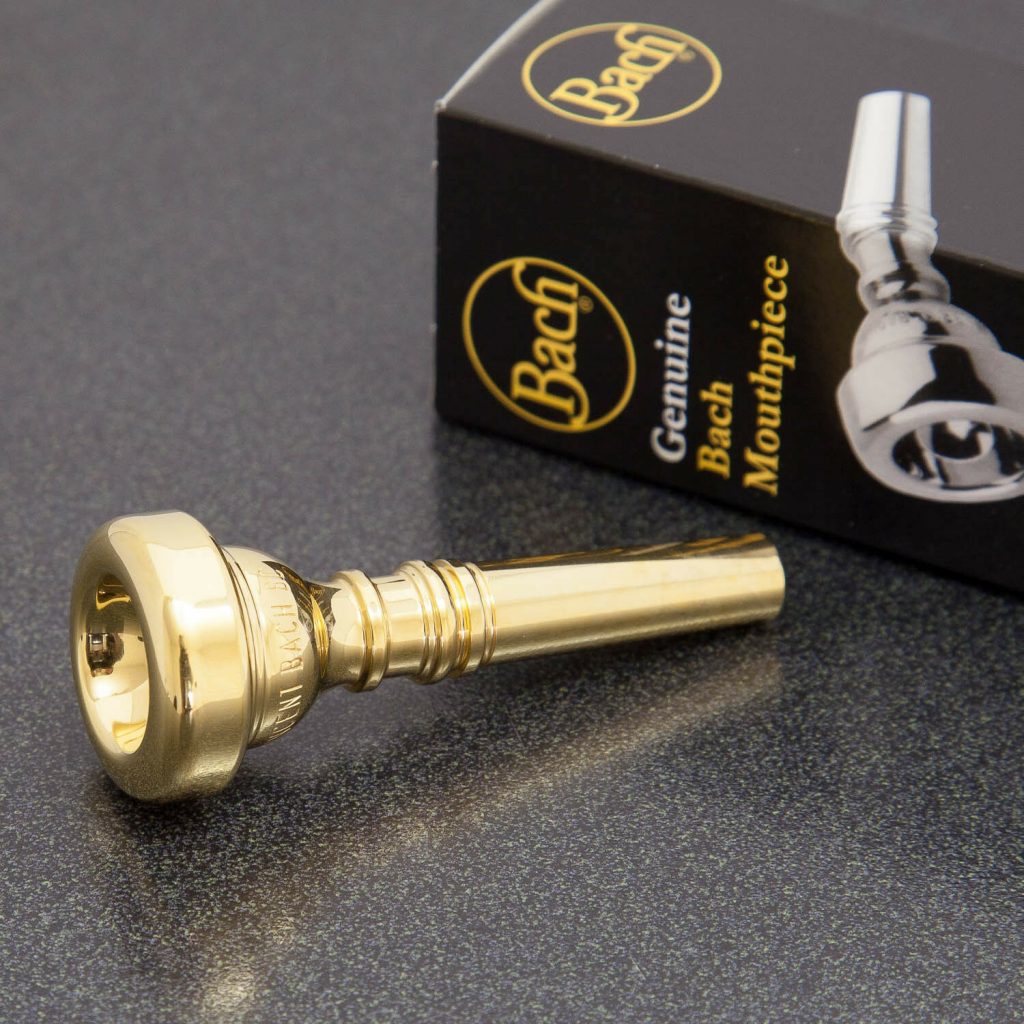 There are a variety of different flugelhorn mouthpieces that are differentiated by their tapers. These different tapers will affect your ability to intonate and pass air through your flugelhorn, although it’s easy to change the mouthpiece for one with a different taper after your purchase. If you get a flugelhorn with a mouthpiece and are not happy with the way it plays, consider trying a different mouthpiece before giving up on your instrument.
There are a variety of different flugelhorn mouthpieces that are differentiated by their tapers. These different tapers will affect your ability to intonate and pass air through your flugelhorn, although it’s easy to change the mouthpiece for one with a different taper after your purchase. If you get a flugelhorn with a mouthpiece and are not happy with the way it plays, consider trying a different mouthpiece before giving up on your instrument.
Warranty
Flugelhorns are expensive instruments, so many manufacturers provide warranties to give peace of mind and insure your purchase against defects. Yamaha and Bach offer the longest warranties – up to five years from the date of purchase.
Tips for flugelhorn players
The flugelhorn and trumpet are very similar, so if you are coming from the trumpet switching over will be relatively easy. However, there are important differences that you need to consider.
First, the flugelhorn is generally larger and heavier than the trumpet, so you’ll need to adjust to the added strain of holding it up over longer gigs. Second, the darker sound of the flugelhorn comes from larger-diameter tubing – so you’ll need to adjust your lungs and your playing style to moving more air.
If you are having trouble with your switch to the flugelhorn, consider trying a different mouthpiece or using a flugelhorn with a larger bore. Either of these changes can make it easier to move air through the instrument.





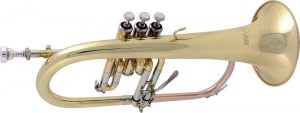
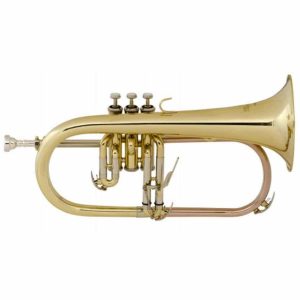
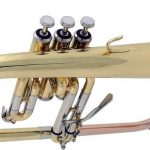
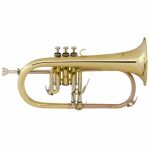
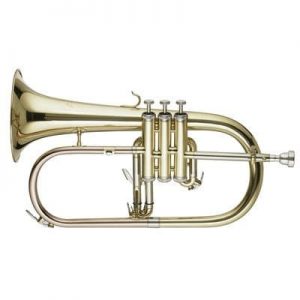
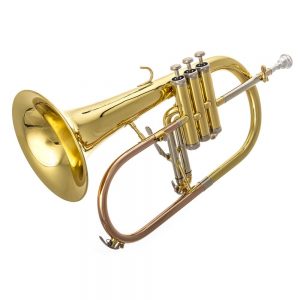
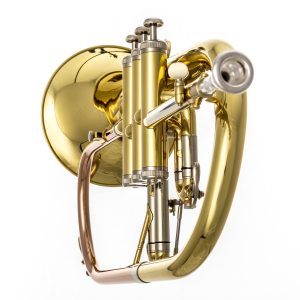
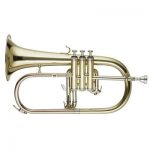
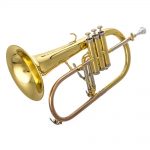
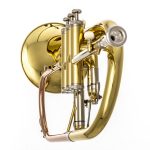
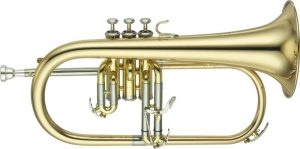
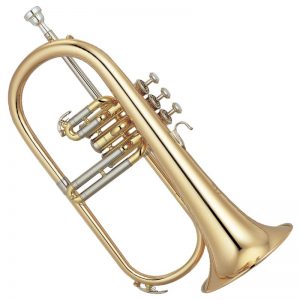
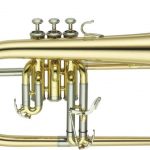
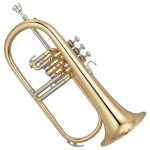
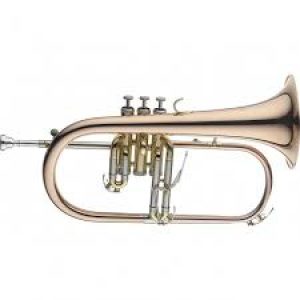
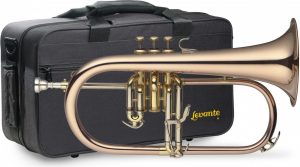










 The dark, yet smooth tone of flugelhorns makes it a favorable addition to a wide variety of music styles. This instrument is most commonly used with brass and jazz bands, and it can often be included in concert bands as well. Although orchestras don’t always have flugelhorns, there are many pieces that do call for a flugelhorn accompaniment. While most flugelhorn musicians focus on improving their skills in one of these four types of music, there are no rules against playing multiple different types of styles with your flugelhorn.
The dark, yet smooth tone of flugelhorns makes it a favorable addition to a wide variety of music styles. This instrument is most commonly used with brass and jazz bands, and it can often be included in concert bands as well. Although orchestras don’t always have flugelhorns, there are many pieces that do call for a flugelhorn accompaniment. While most flugelhorn musicians focus on improving their skills in one of these four types of music, there are no rules against playing multiple different types of styles with your flugelhorn. The vast majority of flugelhorns, including all of the instruments we reviewed, use a three-valve configuration. These flugelhorns include a slide trigger that allows you to extend the range of the instrument with deeper notes.
The vast majority of flugelhorns, including all of the instruments we reviewed, use a three-valve configuration. These flugelhorns include a slide trigger that allows you to extend the range of the instrument with deeper notes. The finish of your flugelhorn’s brass is more than just aesthetic – the finish can also affect sound quality. Silver brass typically produces a brighter sound, closer to the sound of a trumpet, while a yellow or gold brass finish produces the darker sound that flugelhorns are known for. As a result, most flugelhorns opt for a gold brass finish.
The finish of your flugelhorn’s brass is more than just aesthetic – the finish can also affect sound quality. Silver brass typically produces a brighter sound, closer to the sound of a trumpet, while a yellow or gold brass finish produces the darker sound that flugelhorns are known for. As a result, most flugelhorns opt for a gold brass finish. There are a variety of different flugelhorn mouthpieces that are differentiated by their tapers. These different tapers will affect your ability to intonate and pass air through your flugelhorn, although it’s easy to change the mouthpiece for one with a different taper after your purchase. If you get a flugelhorn with a mouthpiece and are not happy with the way it plays, consider trying a different mouthpiece before giving up on your instrument.
There are a variety of different flugelhorn mouthpieces that are differentiated by their tapers. These different tapers will affect your ability to intonate and pass air through your flugelhorn, although it’s easy to change the mouthpiece for one with a different taper after your purchase. If you get a flugelhorn with a mouthpiece and are not happy with the way it plays, consider trying a different mouthpiece before giving up on your instrument.










Are these flugelhorns the only ones available?
The Flugelhorn sound was developed by Antoine Courtois, Paris, in the early days 1940s/50s. But along with the sound, build quality and real professional production came the very high price, so many players opted for monopole range of flugelhorns that cost a lot less because they were not in the same league as Courtois but had the true flugelhorn sound, so I wish you could include the brand’s instrument in your list.
Also, I have been using a Jupiter 846RS for a while and feel that it would be a great instrument to review.
Greetings, Seline and thank you for your feedback.
Even though flugelhorns have started their way in Germany, it is true that Antoine Courtois has perfected the instrument’s construction and sound. Unfortunately, we haven’t been able to successfully cooperate with the manufacturer due to their lack of interest in sending their instrument to our expert’s location. We hope that in the future we’d be able to deliver a full review of the best Courtois flugelhorns and all the other instruments available.
Regarding your request to include Jupiter 846RS in our list, we feel like this instrument hasn’t performed better than our choice for the professional flugelhorns Yamaha YFH-631G and the feedback from the users was not informative enough for us to write a detailed instrument’s description. If you have essential information regarding the instrument and you feel that it must be on our list, please, contact us and give your comprehensive opinion on the sound, construction, and usage of the Jupiter 846RS flugelhorn.